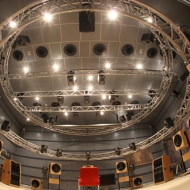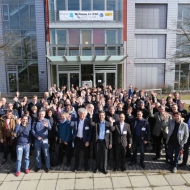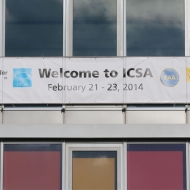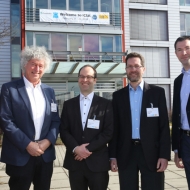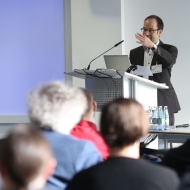To combine theory and practice, and to create a platform for the full and free exchange of ideas, Fraunhofer IIS served as a venue for the 2nd “International Conference on Spatial Audio” (ICSA), which took place from 21st to 23rd February, 2014. For this event the institute cooperated closely with the German tonmeister association “Verband Deutscher Tonmeister” (VDT) and the German Acoustical Society “Deutsche Gesellschaft für Akustik e. V.” (DEGA). Tonmeisters, sound engineers and researchers met in Erlangen for a fruitful exchange of experiences, discussions and questions, and to examine the latest developments regarding the recording, production, reproduction and quality evaluation of spatial sound. We spoke with Dr. Andreas Silzle, senior scientist at Fraunhofer IIS and initiator of the event in Erlangen:
Why was Fraunhofer IIS chosen to host the event?
My colleagues and I are working on a new TV audio system being considered for forthcoming television standards such as ATSC 3.0. The system is based on the open ISO standard MPEG-H audio and promises to transmit immersive sound with additional front and rear height speaker channels to provide a truly realistic audio experience. For this reason, the Institute was an excellent location to communicate with the audio community on this topic. Moreover, the combination of science, art and practice during the first conference at the Hochschule für Musik (HfM), a university for music education located in Germany, during 2011 was an inspiring experience. For this reason I searched for a continuation of this event.
Could you please give us a short summary of the three days?
With 18 well-attended workshops including 3D audio demos, 28 talks and 10 posters we were very satisfied with the conference. This year’s ICSA brought together experts with practical and theoretical knowledge for the second time and gave them the unique possibility to get in contact with other international specialists to talk about technical issues, to learn from each other, and to obtain new impulses for their own work. Therefore it was important to highlight the topic from various perspectives. Among the participants of the event were researchers, tonmeisters, programmers, engineers and sound artists. This enabled a comprehensive view of the topic of spatial audio: from basic research, to recording and production, to the creation of immersive sound.
What were the highlights of ICSA 2014?
One of the highlights of this year’s ICSA was the round table talk with technology leaders working in the field of 3D audio. Francis Rumsey (Logophon Ltd.), who opened the entire event with his keynote speech “Spatial audio – reconstructing reality or creating illusion?”, led the discussion on the topic “3D audio systems”. Together with Jan Plogsties (Fraunhofer IIS), Bert Van Daele (Auro Technologies), Frank Melchior (BBC Research & Development), Ton Kalker (DTS, Inc.) and Nicolas Tsingos (Dolby Laboratories, Inc.) he discussed the scope of new audio formats, the benefits of immersive sound, and emerging distribution channels to reach the audience or for the use for broadcasters.
The talks, workshops and discussions provided a highly revealing insight into and overview of this complex topic. The event focused on wave field synthesis and higher order ambisonics (HOA), high-quality multichannel production and reproduction, recording, transmission and processing of audio signals, or perception and quality evaluation of 3D audio. Different 3D audio previews were also a main part of the event. Two acoustically optimal treated rooms were each equipped with a 5+5 loudspeaker setup for a total of 82 listeners. One specific highlight was the reproduction of 3D audio with a 22.2 system via headphones.
The scientific articles relating to the lectures of this year’s ICSA and a video of the round table talk are available on the website (www.tonmeister.de).
The next ICSA will take place in September 2015 in Graz. The University of Music and Performing Arts, Vienna (MDW) and the Institute of Electronic Music and Acoustics (IEM) will take the lead of the event.
Header image © Fraunhofer IIS/Kurt Fuchs


